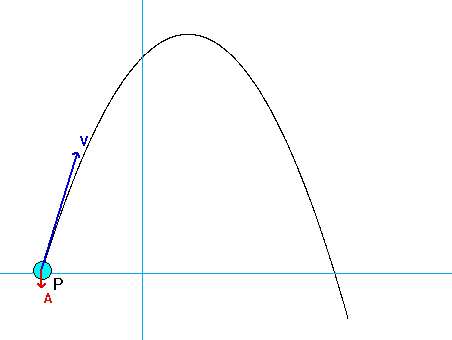| Problem statement Solution video |
DISCUSSION THREAD
Given: A particle P travels on a path described by the Cartesian coordinates of y = cx(b-x). The x-component of velocity for P is a constant.
Ask and answer questions through the "Leave a Comment" link above. You can learn as much by answering the questions of others as you do from asking questions.
From the animation below, you see that the velocity of P is always tangent to the path, and that the acceleration always points inward of the path. In the next class when we discuss the path description of kinematics, we will discover that this is true in general.
Note below that in this case the acceleration of P is always vertical. Do you know why?

HINTS:
The path of P is not given in terms of x- and y-coordinates that are known explicit functions of time (instead, the y-coordinate depends explicitly on the x-coordinate). For velocity and acceleration, we need the derivatives of x and y with respect to time. How do we do this? Recall the chain rule of differentiation:
dy/dt = (dy/dx)*(dx/dt)
Use this in setting up the components of velocity and acceleration.
For this problem, you're not given x and y as functions of time. This means you must use the chain rule of differentiation like we did in lecture today to find the velocity and acceleration components.
Here on Freeform it says something along the lines of "do you know why acceleration is always vertical." Is this something that needs to be answered in our submission, or just something to think about/discuss while solving?
Mark:
No, the problem is defined in the problem statement accessed through the link above. You need to only answer the questions posed there.
The question to which you refer above is posed only to have you reflect on the results. If x_dot = constant, then x_ddot = 0. Therefore, the acceleration of P has only a y-component.
A good way to start this problem is to look at the animation provided as that helped me visualize what the velocity and acceleration should look like at the locations given.
Should the vector sketches be to scale?
Note that the units for v and a are not the same. Comparing scales for the two vectors is not meaningful.
For this problem is c= 5m or c= 5/m. I can not tell if it is a typo and its 5 meters or 5 over m.
Using the path equation of: y =c*x*(b-x), you see that since y is in meters then c*x must have be dimensionless (no units). Since x has units of meters, then c must have units of 1/meters.
Remember that the dot notation refers to the instantaneous rate of change with respect to time. When you derive the function y with respect to x, that is (dy/dx), not dy/dt. Only with the chain rule can you get y dot.
Looking at the lecture summary helped a lot for this problem when reviewing the chain rule, which is necessary for this problem.